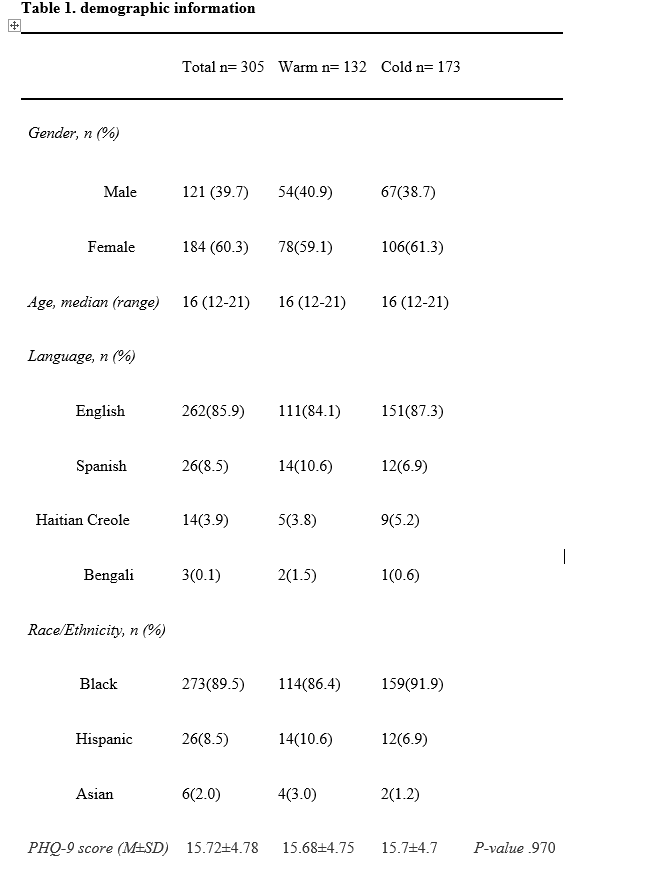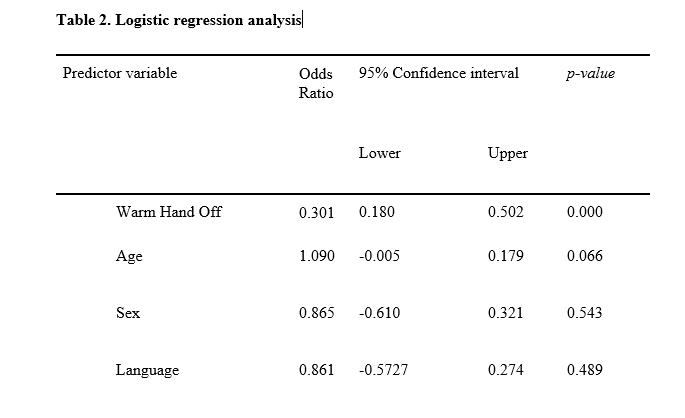Mental Health
Category: Abstract Submission
Mental Health I
530 - Warm Hand-offs Improve Adherence to Mental Health Services Co-located in a Pediatric Primary Care Clinic
Monday, April 25, 2022
3:30 PM - 6:00 PM US MT
Poster Number: 530
Publication Number: 530.422
Publication Number: 530.422
Paridhi Anand, NYC Health and Hospital/Kings County, Brooklyn, NY, United States; Ninad Desai, State University of New York Downstate Medical Center College of Medicine, Brooklyn, NY, United States

Paridhi Anand, MD (she/her/hers)
Associate Director of Pediatric Ambulatory care
NYC Health and Hospitals/Kings County
Brooklyn, New York, United States
Presenting Author(s)
Background: Behavioral health (BH) problems are very common among adolescents in US. Depression occurs in 13.3% of adolescents 12-17years & is associated with significant morbidity, ER visits and hospitalizations. This supports early identification & treatment of mental illness. While the number of child psychiatrists went up from 2007-2010, only 47.9% of adolescent office visits for mental health diagnoses were to a psychiatrist. Hence the primary care pediatrician (PCP) has had to adapt to the needs of their patients. However, they face barriers in knowledge & skills, time & limited mental health referral resources. A mental health care delivery model that may mitigate some barriers is the Collaborative Care (CC) model which generally calls for some physical proximity between PCP and BH clinicians. Even so, engagement in & adherence to therapy remains a challenge for adolescent patients.Transitions of care between providers are often associated with disruption in care. The benefit of real-time referrals has been shown to be beneficial in many settings. Such referrals termed “warm hand-off” are particularly beneficial for services that tend to be stigmatized or difficult to access.
Objective: Analyze if the type of hand-off by PCP to BH clinician affects adherence to therapy
Design/Methods: The study was conducted in a pediatric clinic of a large publicly funded inner-city hospital & included patients aged 12-21 over 8 months. The clinic used co-located CC model. Patients with PHQ-9 score of >/=10 were referred to a Licensed Medical Social Worker(LMSW) & the referral type was recorded. Age, sex, language, race/ethnicity were recorded. Warm handoff was defined as referral by PCP to LMSW in person with the patient/family. The alternative was a referral via EMR. The outcome variable of adherence was defined as >/=3 visits for therapy. Datalog was maintained by the LMSW blinded to the aim of this study and provided to us in a de-identified manner. SPSS was used to run logistic regression analysis
Results: In the period of the study 2213 unique visits were documented with a PHQ-9 score. 305 referrals were made to the LMSW of which 132 patients had a “warm hand-off” while 173 were referred via EMR. Increase in age increased adherence, sex and language had no effect. Warm Handoff group was 3.3 times more likely to have adherence
Conclusion(s): Our study of integration of mental health in primary care via warm handoffs showed that it increased adherence to care among adolescents, which is an important factor in the improvement of mental health disorders. Older adolescents are more likely to be adherent to care.
Demographic information
Logistic regression analysis
Objective: Analyze if the type of hand-off by PCP to BH clinician affects adherence to therapy
Design/Methods: The study was conducted in a pediatric clinic of a large publicly funded inner-city hospital & included patients aged 12-21 over 8 months. The clinic used co-located CC model. Patients with PHQ-9 score of >/=10 were referred to a Licensed Medical Social Worker(LMSW) & the referral type was recorded. Age, sex, language, race/ethnicity were recorded. Warm handoff was defined as referral by PCP to LMSW in person with the patient/family. The alternative was a referral via EMR. The outcome variable of adherence was defined as >/=3 visits for therapy. Datalog was maintained by the LMSW blinded to the aim of this study and provided to us in a de-identified manner. SPSS was used to run logistic regression analysis
Results: In the period of the study 2213 unique visits were documented with a PHQ-9 score. 305 referrals were made to the LMSW of which 132 patients had a “warm hand-off” while 173 were referred via EMR. Increase in age increased adherence, sex and language had no effect. Warm Handoff group was 3.3 times more likely to have adherence
Conclusion(s): Our study of integration of mental health in primary care via warm handoffs showed that it increased adherence to care among adolescents, which is an important factor in the improvement of mental health disorders. Older adolescents are more likely to be adherent to care.
Demographic information

Logistic regression analysis

